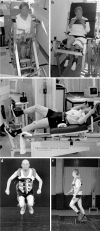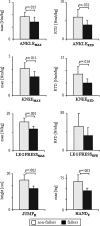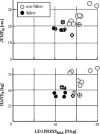Identification of elderly fallers by muscle strength measures
- PMID: 18071745
- PMCID: PMC2226001
- DOI: 10.1007/s00421-007-0613-6
Identification of elderly fallers by muscle strength measures
Abstract
For efficient prevention of falls among older adults, individuals at a high risk of falling need to be identified. In this study, we searched for muscle strength measures that best identified those individuals who would fall after a gait perturbation and those who recovered their balance. Seventeen healthy older adults performed a range of muscle strength tests. We measured maximum and rate of development of ankle plantar flexion moment, knee extension moment and whole leg push-off force, as well as maximum jump height and hand grip strength. Subsequently, their capacity to regain balance after tripping over an obstacle was determined experimentally. Seven of the participants were classified as fallers based on the tripping outcome. Maximum isometric push-off force in a leg press apparatus was the best measure to identify the fallers, as cross-validation of a discriminant model with this variable resulted in the best classification (86% sensitivity and 90% specificity). Jump height and hand grip strength were strongly correlated to leg press force (r = 0.82 and 0.59, respectively) and can also be used to identify fallers, although with slightly lower specificity. These results indicate that whole leg extension strength is associated with the ability to prevent a fall after a gait perturbation and might be used to identify the elderly at risk of falling.
Figures



References
-
- {'text': '', 'ref_index': 1, 'ids': [{'type': 'DOI', 'value': '10.1007/s00221-004-1950-x', 'is_inner': False, 'url': 'https://doi.org/10.1007/s00221-004-1950-x'}, {'type': 'PubMed', 'value': '15241574', 'is_inner': True, 'url': 'https://pubmed.ncbi.nlm.nih.gov/15241574/'}]}
- Barry BK, Carson RG (2004) Transfer of resistance training to enhance rapid coordinated force production by older adults. Exp Brain Res 159(2):225–238 - PubMed
-
- {'text': '', 'ref_index': 1, 'ids': [{'type': 'DOI', 'value': '10.1093/ageing/26.4.261', 'is_inner': False, 'url': 'https://doi.org/10.1093/ageing/26.4.261'}, {'type': 'PubMed', 'value': '9271288', 'is_inner': True, 'url': 'https://pubmed.ncbi.nlm.nih.gov/9271288/'}]}
- Berg WP, Alessio HM, Mills EM, Tong C (1997) Circumstances and consequences of falls in independent community-dwelling older adults. Age Ageing 26(4):261–268 - PubMed
-
- {'text': '', 'ref_index': 1, 'ids': [{'type': 'DOI', 'value': '10.1016/j.gaitpost.2006.09.010', 'is_inner': False, 'url': 'https://doi.org/10.1016/j.gaitpost.2006.09.010'}, {'type': 'PubMed', 'value': '17046260', 'is_inner': True, 'url': 'https://pubmed.ncbi.nlm.nih.gov/17046260/'}]}
- Bieryla KA, Madigan ML, Nussbaum MA (2007) Practicing recovery from a simulated trip improves recovery kinematics after an actual trip. Gait Posture 26(2):208–213 - PubMed
-
- {'text': '', 'ref_index': 1, 'ids': [{'type': 'DOI', 'value': '10.1016/j.gaitpost.2006.06.007', 'is_inner': False, 'url': 'https://doi.org/10.1016/j.gaitpost.2006.06.007'}, {'type': 'PubMed', 'value': '16876417', 'is_inner': True, 'url': 'https://pubmed.ncbi.nlm.nih.gov/16876417/'}]}
- Chambers AJ, Cham R (2007) Slip-related muscle activation patterns in the stance leg during walking. Gait Posture 25(4):565 - PubMed
-
- {'text': '', 'ref_index': 1, 'ids': [{'type': 'DOI', 'value': '10.1037/0033-2909.115.3.465', 'is_inner': False, 'url': 'https://doi.org/10.1037/0033-2909.115.3.465'}]}
- Cole D, Maxwell S, Arvey R, Salas E (1994) How the power of MANOVA can both increase and decrease as a function of the intercorrelations among the dependent variables. Psychol Bull 115(3):465–474
Publication types
MeSH terms
LinkOut - more resources
Full Text Sources
Other Literature Sources
Medical

